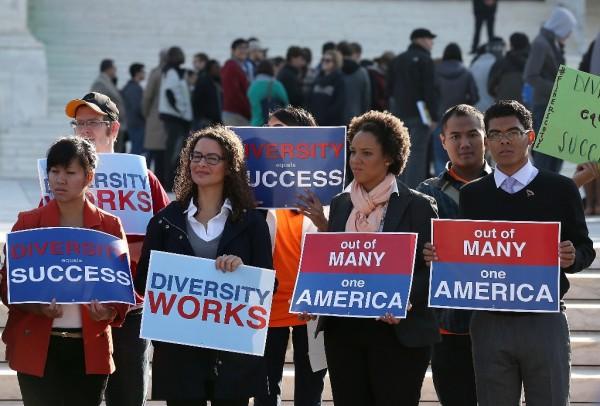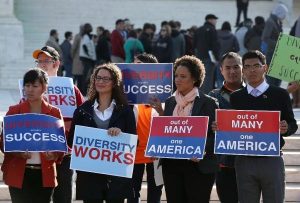By: Taryn Winston
Last October, Taryn examined the affirmative action decision pending before the Supreme Court in Fischer v. University of Texas. Now she explains the consequences of Monday’s 7-1 decision.
Could this be a sign of things to come?
In a somewhat surprising move, the Supreme Court of the United States sent Fisher v. University of Texas at Austin—a potentially groundbreaking case involving the controversial practice of affirmative action—back to the Fifth Circuit Court of Appeals. The 7-1 “decision” vacated the lower court’s ruling that upheld the affirmative action program at the Texas institution.
However, the Court did not explicitly rule that the program was unconstitutional; rather, the majority argued that the Fifth Circuit did not sufficiently apply “strict scrutiny” to determine whether the use of race was narrow enough to serve the university’s goal of maximizing diversity.
Justice Anthony Kennedy announced the opinion early Monday morning, ordering the Fifth Circuit Court to abide by the constitutional standard laid out in Grutter v. Bollinger. The landmark 2003 case held that race could play a role in the admission policies of universities so long as such policies “are narrowly tailored to obtain the educational benefits of [racial] diversity.” Chief Justice John Roberts, and Justices Samuel Alito, Stephen Breyer, and Sonia Sotomayor joined Kennedy’s opinion in its entirety. Justices Antonin Scalia and Clarence Thomas filed separate concurring opinions, with Thomas going so far as to that the Fifth Circuit Court “would require Texas either to close the university or to stop discriminating against applicants based on their race” had they applied the appropriate measure. Justice Ruth Bader Ginsburg was the Court’s lone dissenter, arguing that the institution’s admissions policies are compliant with past precedent as well as with the Constitution.
With Justice Elena Kagan recusing herself from participation, affirmative action supporters could look at the Court’s decision–or lack thereof–as a small victory. This is especially true considering Justices Thomas, Scalia, and Kennedy all dissented from the majority in Grutter and against Michigan’s affirmative action policies. And yet instead of ruling that affirmative action altogether is unconstitutional (though Thomas implied that it was in his concurring opinion), the Justices refrained and chose to defer back to the lower court. Further, Kennedy’s masterfully worded opinion expanded broadly enough to compel two of the Court’s more liberal Justices to avoid making any sweeping decisions. Kennedy–often referred to as the Court’s swing voter–played it safe and in the middle. Consequently, the Court’s diverse majority only solidifies Kennedy’s power and ability to attract both the conservatives and the liberals on the Court.
However, the Court’s decision could also be seen as a major blow to affirmative action policies. By ruling that the Fifth Circuit did not apply strict scrutiny, the Court in essence strengthened the burden on universities–as well as other institutions–to prove that affirmative action is necessary to increase diversity. As Justice Ginsburg alluded to in her dissent, if the university believed that they were in fact practicing strict scrutiny, the Court’s remand makes it significantly more difficult (and almost impossible) to meet the Grutter standard. In fact, to express her dissatisfaction, Ginsburg elected to read her four-page dissent aloud from the bench.
Prior to Monday, Fisher v. University of Texas at Austin was one of several high-profile cases still pending before the Supreme Court. With the current session coming to a close, the Court is expected to announce opinions for two cases involving the constitutionality of gay marriage–United States v. Winsor and Hollingsworth v. Perry–as well as a case questioning the constitutionality of part of the Voting Rights Act–Shelby County v. Holder–among several others. The Court’s decisions could potentially have major implications on the policy and direction of the entire nation.
Yet with the High Court’s decision to punt the power and give Fisher back to the lower court could serve as a potential foreshadow as to how they plan on proceeding. Last year, Chief Justice Roberts demonstrated his reserve when he voted to uphold the controversial healthcare bill in National Federation of Independent Business v. Sebelius. Roberts’ judicial restraint and respect for past precedent certainly had to have played a role in his decision to align with the majority in Fisher. Additionally, Kennedy has historically been hesitant to make sweeping decisions, electing to defer to precedent as well. Thus, with the Court’s two middle justices “side-stepping” controversial rulings, it is reasonable to conclude that they will opt to do the same in the future.
While some are praising the Court’s moderation, others are frustrated that the legality of yet another controversial issues remains in question. Still, if the Fisher ruling tells us anything, it’s that the current Supreme Court does not intend to make any groundbreaking decisions anytime soon. Whether the Court will choose to follow this current trend, however, remains to be seen.
Fortunately, we won’t have long to wait before we find out.



